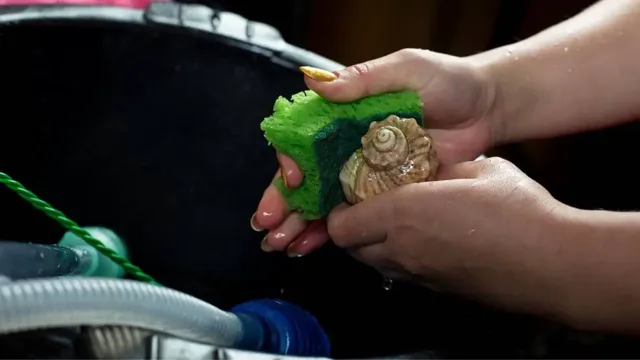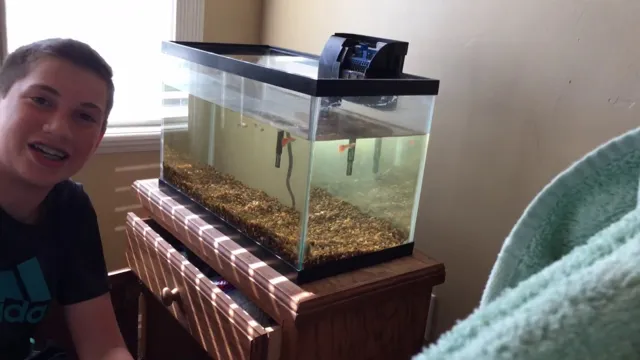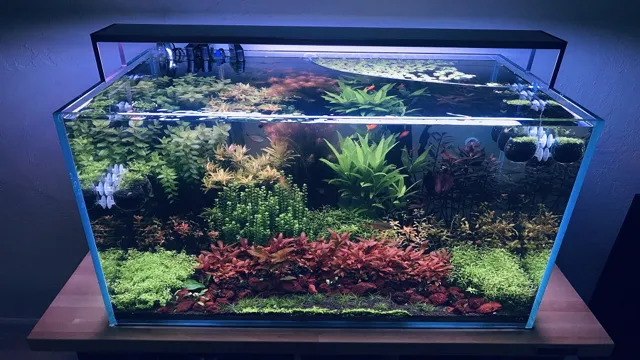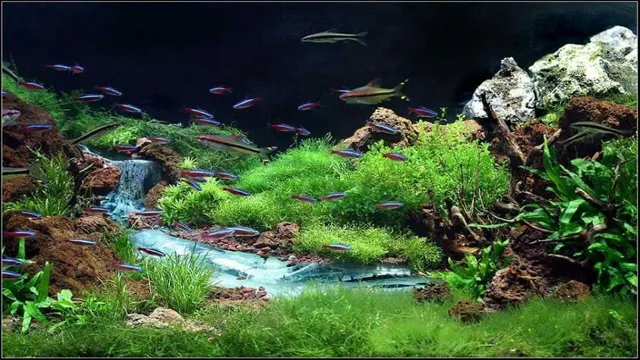Do you dream of having a thriving saltwater aquarium in your home? One of the most important pieces for a healthy and successful saltwater aquarium is a sump system. A sump is essentially an additional tank that sits below your main display tank and functions as a filtration system. It helps to maintain water quality, increase oxygen levels, and provides a place for equipment such as protein skimmers, heaters, and lighting to be housed.
Building a saltwater aquarium sump may seem like a daunting task, but with the right guidance and knowledge, it can be an enjoyable process. The first step is to decide on the size and shape of the sump needed for your specific aquarium setup. You will then need to gather materials such as an aquarium tank, overflow box, return pump, plumbing fittings, and filter media.
It’s important to properly measure and plan out the plumbing and equipment placement before starting the assembly process. Once you have all the necessary components, you can begin constructing the sump system. From drilling holes for plumbing to attaching the overflow box, building a sump requires attention to detail and patience.
However, the benefits of a well-constructed sump can be truly transformative for your saltwater aquarium. It can improve water quality, reduce maintenance, and ultimately lead to a healthier and thriving aquatic environment for your fish, corals, and other marine life. In conclusion, building a saltwater aquarium sump is a key component to achieving success in the hobby.
Though it may seem time-consuming, with proper planning and execution, it can be a fulfilling and rewarding project that will benefit your aquarium for years to come.
What is a Sump?
If you’re thinking about setting up a saltwater aquarium, you may have come across the term “sump.” But what exactly is a sump and why is it important? Essentially, a sump is a separate chamber that sits below the main tank and is used to filter and circulate water. It’s essentially an overflow area that houses equipment like a protein skimmer, heater, and mechanical and biological filters.
A sump helps keep your tank looking clean and clear, as well as maintaining water quality by filtering out impurities and keeping oxygen levels high. If you’re interested in building a saltwater aquarium sump, you’ll first need to choose the size and shape that is appropriate for your main tank. Then, you’ll need to gather the necessary equipment and set up the chambers in the correct order.
Don’t forget to add live rock or other natural filtration media to help balance out the ecosystem and keep your fish and other aquatic creatures happy and healthy. By investing in a sump, you can elevate your saltwater aquarium setup to the next level and enjoy a beautiful and thriving underwater environment.
Explanation of sumps and their benefits for saltwater aquariums
A sump is a separate filtration unit used in saltwater aquariums to improve the water quality and provide additional space for equipment such as protein skimmers, heaters, and pumps. It works by diverting water from the main tank into the sump, where it gets filtered and then pumped back into the aquarium. The sump usually consists of various compartments that house different types of filtration media, including mechanical, biological, and chemical filtration.
These media help to remove waste particles, excess nutrients, and harmful chemicals, thereby improving the overall water quality and reducing the risk of diseases and algae growth. The benefits of using a sump in saltwater aquariums are many, including increased oxygenation, stability, and oxygenation of the water, as well as allowing for easier maintenance and customization of the filtration system. Overall, a sump is an essential piece of equipment for any serious saltwater aquarium hobbyist looking to maintain a healthy and thriving aquatic ecosystem.
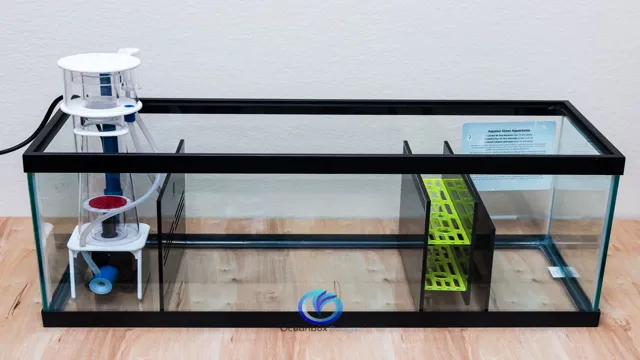
Materials Needed
When building a saltwater aquarium sump, there are a few materials you’ll need to have on hand. First and foremost, you’ll need a suitable container that is large enough to hold all the components of your sump system. You can use an old tank or purchase an acrylic sump from your local aquarium supply store.
Next, you’ll need a return pump, which will circulate the water from the sump back into your display tank. It’s essential to choose a pump that is appropriately sized for your tank and offers the correct flow rate. You’ll also need to purchase a protein skimmer, which will help remove any organic waste from your aquarium water.
Finally, you’ll need a variety of plumbing fittings and hoses to connect everything together. With these materials in hand, you’re ready to start building your own saltwater aquarium sump and improve the health of your aquatic pets. (See Also: How to Make an Incubator for Chicken Eggs Aquarium: A Step-by-Step Guide)
List of necessary materials to build a saltwater aquarium sump
When it comes to building a saltwater aquarium sump, there are several materials you will need to ensure your sump functions correctly. Firstly, you will need a tank or container that is large enough to hold all the equipment needed, and it should be made from a material that can withstand the corrosive nature of saltwater. You will also need a set of PVC pipes for plumbing, as well as a return pump to move water from the sump back into the main tank.
Other materials include filter media, such as mechanical filter pads and biological media, a protein skimmer, and a heater to maintain the appropriate water temperature. An overflow box is also necessary to regulate the water levels, and a bubble trap will prevent excess air from entering the system. Lastly, you will need a sump cover or lid to prevent any evaporation or splashing that could lead to salt creep.
By gathering these necessary materials, you can ensure your saltwater aquarium sump functions correctly and provides a healthy environment for your aquatic pets.
Planning the Sump
Building a saltwater aquarium sump can be an exciting project for any hobbyist. Planning the sump is the first and most crucial step to ensure a successful system. When planning the sump, it is essential to consider the tank’s size, the type of equipment that will be used, and the space in the stand.
Determine the desired water level in the sump and choose the appropriate size for the overflow box. It is also recommended to add a mechanical filter to the sump to remove larger particles before water enters the biological filter. Lastly, it’s important to ensure adequate space for the return pump and any additional equipment necessary for the system.
Overall, careful planning and consideration can lead to a functional and efficient sump for a thriving saltwater aquarium.
Tips for designing the layout of the sump and considering tank size
When planning the layout of a sump for your aquarium, there are a few things to consider to ensure a successful design. Firstly, it’s essential to choose a sump size that is appropriate for your tank. As a general rule, your sump should be at least 20% of the total water volume of your tank.
This ensures that enough water is being processed through the sump to maintain a healthy environment for your fish. Additionally, it’s important to think about the placement of the sump in relation to your tank’s overall layout. Ensuring that the sump is easily accessible for maintenance is vital.
Another factor to consider is the type of equipment you will be using in your sump, such as heaters and protein skimmers. These should be positioned in a way that allows them to function efficiently without interfering with the flow of water through the sump. With careful planning and consideration, designing an effective sump layout can help to create a thriving aquatic environment for your fish.
Building the Sump
If you’re building a saltwater aquarium, a sump is an essential part of the setup. A sump can add extra filtration, provide a location for equipment, and increase the overall water volume of your reef tank. To build a sump, you’ll need a basic understanding of filtration systems and some basic equipment.
First, you’ll need to select a container to hold the sump. This can be a pre-made aquarium, a plastic container, or even a modified water tank. Then, you’ll need to install overflow boxes or bulkheads to create a flow of water from your main tank to the sump.
Next, you’ll add filtration media like filter socks, protein skimmers, and a refugium that can promote growth of beneficial bacteria. Finally, you’ll install the return pump that will bring water back up to your main tank. By building a sump, you can create a thriving ecosystem for your fish and corals, ensuring that your saltwater aquarium remains healthy and beautiful for years to come.
Step-by-step instructions for constructing the sump
If you’re looking to build a sump for your aquarium, the first step is to gather all the necessary materials. You’ll need a sump tank, a return pump, PVC pipes, and plumbing fittings. Once you have everything you need, it’s time to start building. (See Also: How to Make an Aquarium Drip Plate with Plastic Pegboard: A Step-by-Step Guide)
First, drill a hole in the sump tank’s side to fit the overflow box. Then, attach the overflow box to the sump tank with silicone adhesive. Next, connect the PVC pipes to the overflow box and the return pump, making sure to use plenty of sealant to prevent leaks.
Finally, position the sump tank below the main aquarium and fill it with water to test the system. With a little patience and careful attention to detail, you’ll have a fully functioning sump in no time! By following these step-by-step instructions, you’ll be able to construct a sump that will help keep your aquarium water clean and healthy for your fish and other aquatic creatures to thrive.
Adding Equipment to the Sump
Once you have built your saltwater aquarium sump, it’s time to add equipment to make sure that your aquarium thrives. You should start by adding a heater to maintain a steady temperature within the sump and the aquarium. Next, consider adding a protein skimmer to help remove leftover food and waste particles from the water as they can negatively affect water quality and the health of your fish.
Another equipment that can be added is a refugium, which is essentially a small ecosystem within the sump that can house beneficial microorganisms and macroalgae. Finally, you can also add a return pump to circulate the water between the sump and the main tank. Ensuring that all the equipment is appropriately installed and correctly sized is crucial.
Keep in mind that every piece of equipment can affect water flow and water quality, so it’s essential to research and understand how each component fits into your aquarium system. By taking care of these things, you can ensure that your saltwater aquarium thrives.
How to properly install equipment, such as protein skimmers and heaters, in the sump
Adding equipment to the sump can seem like a daunting task, but with a little preparation, it can be a breeze. One crucial factor to consider is the proper placement of the equipment within the sump. When it comes to protein skimmers, it is best to install them at the beginning of the sump before any filter media to allow for maximum efficiency.
Similarly, heaters should be placed near the return pump to ensure that the water returning to the tank is at the desired temperature. When installing equipment, it is crucial to maintain proper flow within the sump, as an obstructed flow can lead to equipment failure and adversely affect the aquarium’s overall health. Take the time to plan out the layout of the equipment before installation, considering the space required for adjustments and cleaning.
Overall, by strategically adding equipment to the sump, you can maintain optimal conditions for your aquatic pets and elevate your aquarium’s overall health and appearance.
Maintaining the Sump
Building a saltwater aquarium sump is an excellent way to ensure that your tank remains clean and healthy. But once you’ve put all that effort into creating the ideal sump, it’s essential to maintain it. Regular checks and cleaning can prevent problems from developing and ensure that your sump provides the best possible filtration.
Start by checking the water levels and ensuring that they stay consistent. Skimming off any debris, like uneaten fish food, is also crucial, as it can quickly lead to a buildup of harmful bacteria. Additionally, keep an eye on the equipment in your sump, like pumps and heaters.
Regularly cleaning these components can keep them running smoothly and prolong their lifespan. By regularly maintaining your sump, you’re taking an essential step towards ensuring the success of your saltwater aquarium.
Tips for cleaning and maintaining the sump to ensure optimal performance
Sump maintenance plays an essential role in ensuring optimal performance. Regular cleaning and upkeep of the sump are crucial to keep the aquarium water clean and the equipment functioning correctly. One of the essential tips to maintain a sump is to perform regular water changes in the aquarium. (See Also: How to Make Faux Birch Trees for Aquarium: A Step-by-Step Guide)
Changing the water on a weekly or bi-weekly basis could help remove debris and dirt that may have accumulated in the sump. Additionally, you could clean the sump filter, skimmer, and pumps once or twice a month to prevent clogging and loss of performance. Another critical aspect of sump maintenance is monitoring the water level.
The sump should have adequate water levels, not exceeding or falling short of the designated level, as this could harm the equipment. In conclusion, maintaining a sump requires consistent efforts, but it is worth it in the long run. A well-maintained sump could enhance the health of the aquarium inhabitants, minimize equipment malfunction, and keep your aquarium looking great.
Final Thoughts
In conclusion, building a saltwater aquarium sump may seem like a daunting task, but it doesn’t have to be. By following the steps outlined in this guide, you can create a functional and efficient sump system that will keep your aquarium healthy and thriving. Remember to choose quality equipment, plan your design carefully, and maintain regular upkeep.
Your sump will become an essential part of your saltwater aquarium, providing filtration and keeping your water chemistry balanced. With some patience and dedication, you can create a custom sump system that is perfect for your aquarium and the unique needs of your aquatic inhabitants. So, don’t be intimidated by the process, dive in, and create the ultimate sump system for your saltwater aquarium.
Summary of the benefits of using a sump and the importance of proper maintenance
In summary, utilizing a sump in an aquarium setup provides numerous benefits such as increased water volume, improved water quality, and the opportunity to incorporate equipment such as protein skimmers and heaters. However, it is crucial to properly maintain the sump to avoid any potential disasters. Regular water changes and cleaning of the sump and equipment are necessary to prevent the buildup of harmful substances and ensure efficient performance.
Neglecting this crucial step can lead to issues such as algae blooms, ammonia spikes, and equipment failure. In essence, while a sump can greatly benefit your aquarium, it is important to make maintenance a top priority to ensure its effectiveness and longevity.
Conclusion
In conclusion, building a saltwater aquarium sump requires precision, patience, and a little bit of creativity. It’s not just about getting the right materials and following the steps; it’s about understanding how your system works and what you want it to achieve. You need to be willing to adapt, troubleshoot, and have fun with this project.
So, grab your tools, get ready to dive in, and remember that just like a good joke, a well-built sump is something to be appreciated and admired.”
FAQs
1. What is a saltwater aquarium sump and why is it important for your aquarium? A: A saltwater aquarium sump is an additional tank that is connected to the main tank to perform filtration and other functions that can improve the water quality and overall health of your aquarium. 2. What are some of the benefits of using a sump in your saltwater aquarium? A: Using a sump can help with better water filtration, oxygenation, protein skimming, and provide a way to hide equipment from view, leading to a cleaner and healthier saltwater aquarium. 3. What size sump should you consider for your saltwater aquarium? A: The size of your sump depends on the size of your main tank and how much filtration you require. A rule of thumb is to choose a sump that is at least a third of the size of your main tank. 4. What equipment do you need to include in your saltwater aquarium sump? A: The equipment you need may vary depending on your needs, but some common items to include are a protein skimmer, a return pump, heaters, and mechanical and biological filtration media. 5. How do you install a saltwater aquarium sump? A: To install a sump, you need to connect it to your main tank using plumbing and hoses. Ensure that the sump is properly leveled and allow the water to flow into the sump before turning on the equipment. 6. How often should you clean your saltwater aquarium sump? A: It is recommended to clean your sump every three to six months, depending on how heavily stocked your tank is and how much waste is produced. 7. What kind of maintenance is required for your saltwater aquarium sump? A: Regular maintenance should include cleaning your mechanical and biological filtration media, replacing filter socks, and checking for any leaks or malfunctions in the equipment.



